
Aug 15, 2017, 11:00 AM
Basic Corn Diseases
Each year across the corn growing region, producers are faced with plant diseases, either early season seedling diseases, mid-season foliar diseases, or late season stalk diseases. These can vary from many different pathogens, depending on environment, farming and tillage practices, hybrid selection, and weather patterns for that year. It is very important to be proactively scouting corn fields for disease, as crop yield and quality can be greatly affected in areas with high disease pressure. In order for a disease to develop, we need to remember the disease triangle:

When all three conditions of the triangle exist, disease of some sort is likely to occur, not necessarily to a treatment threshold, but occur none the less. Following is a brief summary of the most commonly seen foliar diseases in the upper Midwest.
When you are looking at your fields and scouting, here is a general summary of the symptoms of common corn diseases:
Common Rust
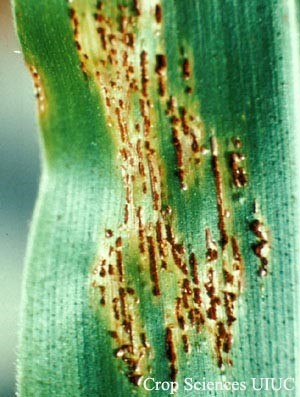
- Fungal pathogen, occurs very frequently
- Prefers cool temperatures (60-76°F) along with 6 hours of moisture for infections to occur
- Spores are wind blown from Mexico and the Gulf States
- Causes random dark reddish brown pustules to form on either side of leaf
- Management – resistant hybrids, fungicide applications if needed
Southern Rust
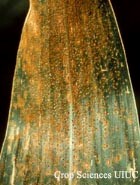
- Fungal pathogen, somewhat common late season
- Prefers warm temperatures (77-82°F) along with 6 hours of moisture
- Spores are wind blown from Mexico and Gulf States
- Causes small orange to brown pustules on top side of leaf in a cluster with halo around spores
- Management – resistant hybrids, fungicide application if needed
Common Smut
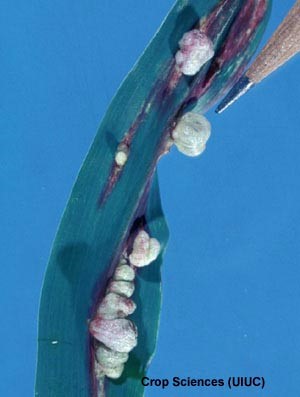
- Fungal pathogen, very common
- Overwinters in soil and can be wind blown
- Spores can germinate season long (50-95°F)
- Rarely severe but can become severe, especially on young plants, after an injury
- Forms a smut gall on any part of the plant above ground
- Management – resistant hybrids, crop rotation, proper soil fertility, tillage
Eye Spot
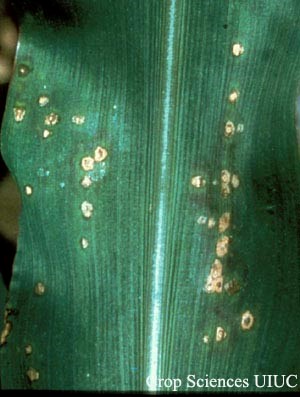
- Fungal pathogen, fairly common
- Overwinters on corn residue, spores distributed by wind
- Infection takes place during cool, wet weather
- Produces small circular lesions (1/8”) with a tan center, surrounded by a brown to purple ring, surrounded by a yellow halo when held towards light
- Most severe in no-till/ reduced till situations where residue is left on top of the ground
- Management – Hybrid resistance, residue management, crop rotation, fungicide if needed.
Gray Leaf Spot

- Fungal pathogen, common
- Overwinters on corn residue at soil surface
- Infection occurs during prolonged warm and humid conditions
- 75-90°F, 90%+ humidity, and 12 hours leaf wetness
- Can become economically damaging in corn on corn, no till fields
- Early infection creates small, pin point lesions that can be confused with eye spot and common rust
- As pathogen develops, lesions become enlarged, turn brown-gray, and are bound between leaf veins
- Management – Resistant hybrids, residue management, crop rotation, fungicide if needed.
Northern Corn Leaf Blight
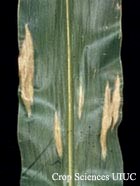
- Fungal pathogen, common
- Overwinters on corn residue at soil surface
- Spores quickly spread through wind and rain splash
- Infection occurs with 6-18 hours of wet leaves, 65-80°F
- Cigar shaped lesions from 1-6” long, gray-green to tan colored
- Starts on lower leaves, and spreads up the plant onto leaves and husks
- Yield losses can range from 30-50% if infected prior to tasseling
- Management – Resistant hybrids, fungicide application, crop rotation
Goss’s Wilt
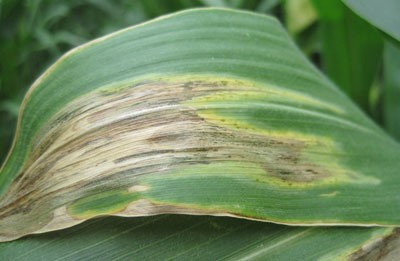
- Bacterial pathogen, very common
- Overwinters on crop residue on soil surface
- Many hosts, including green foxtail and barnyard grass
- Bacteria spread through splashing onto lower leaves of corn plant, typically through an injury on the leaf from wind, hail, insect feeding, etc.
- Disease develops during warm, humid conditions of 80°F and above
- Symptoms are either foliar blight or systemic wilt
- Lesions may be gray to tan in color with wavy, irregular margins that follow the leaf veins
- Dark green to black water-soaked lesions often called “freckles” inside lesion
- Bacterial ooze can be present on leaf surface
- Management – Hybrid tolerance, rotation, tillage, control grassy weeds
- No in-season management available
Holcus Leaf Spot
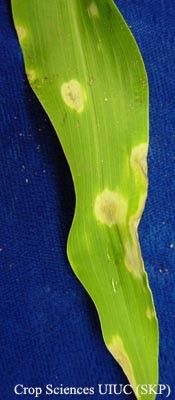
- Bacterial pathogen, somewhat common
- Overwinters on crop debris
- Wounds caused by wind and hail can increase disease symptoms
- Warm (75-85°F) wet, and windy conditions early in growing season favor development
- Wide range of hosts including many grasses and dicots
- Symptoms first appear as water soaked, dark green lesions
- Lesions develop into round, tan to white spots that are 1/8-1/2” in diameter
- Red to brown margins surround the spots with a yellow halo surrounding it all
- Management – Crop rotation and tillage
- No in-season management available
Conclusion
As you can see, there are many different pathogens that can affect your crop. These are just a few of the more common foliar diseases seen throughout the Midwest. Proper identification is critical as the use of a foliar fungicide can be either beneficial on a fungal disease, or an unneeded expense on a bacterial infection. Most universities and labs are able to properly diagnose the disease if there is any question on identification.
Content and Photo Credit: SDSU iGrown, Corn Diseases in South Dakota and Their Management and http://cropdisease.cropsci.illinois.edu/corn

